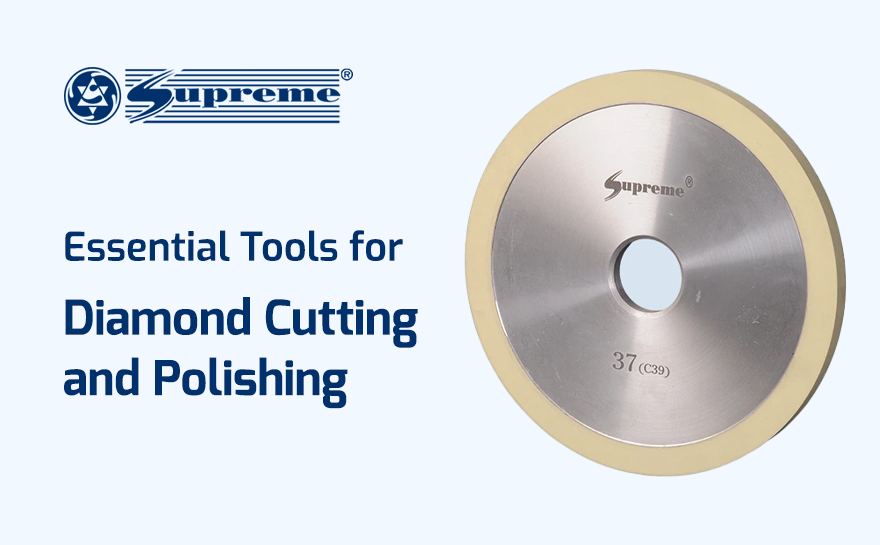When it comes to the art and science of diamond cutting and polishing, the tools you use make a huge difference. Whether you are an experienced jeweler or just starting out, knowing the right diamond cutting tools and polishing tools can improve your work quality and save time.
Why Tools Matter
Diamond cutting and polishing is a careful process that turns rough diamonds into beautiful gemstones. The main goal is precision, and this can only be achieved with the proper tools and methods.
The Process Step by Step
The process usually includes several stages:
- Planning – Deciding the best way to cut the diamond.
- Cleaving or Sawing – Splitting or cutting the rough diamond into smaller pieces.
- Bruting – Shaping the diamond into a round form.
- Polishing – Giving the diamond its final sparkle and shine.
- Inspection – Checking the quality to make sure the gemstone is flawless.
By using the right diamond cutting and polishing tools, each step becomes more accurate and efficient.
Planning and Marking
Before cutting a diamond, planning and marking are very important. This step helps decide the best cut to make the diamond look beautiful and valuable.
Experts often use advanced software and laser markers at this stage to ensure everything is accurate. Proper planning helps make sure the diamond is cut perfectly, reducing waste and increasing its quality.
Cutting Tools
Cutting tools are the most important part of diamond processing. They are made to handle the extreme hardness of diamonds.
Metal Bonded Diamond Wheels
Metal bonded diamond wheels are used for sawing and shaping diamonds. They have tiny diamond particles set in metal, which makes them strong and precise. These wheels are also used in construction and manufacturing because they can cut other hard materials too.
Resin Bond Diamond Girdle Wheel
The resin bond diamond girdle wheel is used for girdling, which means shaping the diamond into a round form. The resin helps give a smooth finish, which is important for making the perfect girdle diameter. This tool is useful not only in jewelry making but also in other areas where precise shaping is needed.
Polishing Tools
After a diamond is cut, polishing tools are used to make its surface smooth and shiny. This helps improve its brilliance and clarity.
Supreme Abrasives
Supreme abrasives are high-quality polishing tools that give diamonds a mirror-like finish. They come in different forms like powders, pastes, and pads and are very important in the final stages of diamond processing.
Synthetic Diamond Powder
Synthetic diamond powder is a versatile polishing material. Its even particle size helps achieve a consistent, high-quality polish. This powder is also used in electronics and optics, where very smooth surfaces are needed.
Vitrified Diamond Bruting Wheel
The vitrified diamond bruting wheel is used to round diamonds and prepare them for polishing. Its vitrified bond makes it strong and precise, allowing for accurate shaping. This tool ensures that diamonds are perfectly round, which is very important for their optical qualities.
Polishing Compounds
Polishing compounds are used to make diamonds shine and look smooth. They are applied in the final polishing stage to remove any small surface flaws.
Diamond Polishing Compounds
Diamond polishing compounds are made of tiny diamond particles mixed with a carrier material. These compounds give a high-gloss finish, showing off the diamond’s natural sparkle.
They are used in jewelry to make diamonds shine beautifully. They are also helpful in automotive and aerospace industries for polishing precision parts.
Innovations in Diamond Tools
The world of diamond cutting and polishing keeps improving, with new tools making work faster and more precise.
Technological Advances
Recent innovations include:
- Computer-aided design (CAD) software to plan cuts and predict results.
- Laser technology for very precise cuts.
- Automated polishing machines that give a smooth and consistent finish.
Environmental Considerations
The diamond industry is also focusing on sustainable practices. New eco-friendly diamond cutting and polishing tools are being developed to reduce environmental impact and support responsible diamond sourcing.
Conclusion
The right tools are key to successful diamond cutting and polishing. From metal bonded diamond wheels to polishing compounds, each tool has a special job in turning rough diamonds into beautiful gemstones.
Understanding these tools and how to use them improves your work quality and opens opportunities in different industries. By learning about new tools and techniques, you can stay ahead in this exciting field.
Mastering these essential diamond cutting and polishing tools helps you create stunning, brilliant diamonds and contribute to the art of fine jewelry and industrial applications.
FAQs
1. What is diamond cutting and polishing?
Diamond cutting is the art of shaping a rough stone into a gem. Polishing is then refining its facets to unlock maximum brilliance and fire.
2. Why is a diamond’s polish grade important?
The polish grade assesses the smoothness of the diamond’s facets. Poor polish can create a hazy or blurred appearance, reducing the stone’s clarity and overall ability to reflect light.
3. What is the difference between cutting and polishing a diamond?
Cutting (or cleaving/sawing) is the initial process of shaping the rough stone into a basic form. Polishing is the final step of creating the smooth, reflective facets that give the diamond its brilliant sparkle.
4. How much of the original rough diamond is lost during cutting?
A significant amount can be lost. The yield is typically between 30% to 50%, meaning more than half of the original rough diamond’s weight is often lost during the cutting and polishing process.
5. What are the most essential tools for cutting and polishing a diamond?
The core toolkit includes a diamond saw (often a laser) for cleaving, a dop stick to hold the diamond, a scaife (a rotating cast-iron wheel) for polishing, and diamond powder as the essential abrasive.

